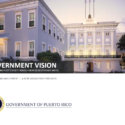What is Puerto Rico’s fiscal plan?
The Governor of Puerto Rico, Ricardo Rossello, prepared a plan for the PROMESA Financial Oversight and Monitoring Board. The plan started off with a quick history lesson, showing a timeline from the time Puerto Rico became a territory of the U.S. to the adoption of the Puerto Rico Constitution.
“Puerto Rico’s unfair and inequitable treatment as a territory has been a driving factor in our decade-old fiscal and economic crisis,” the plan stated.
Some of the goals of the fiscal plan are not about finances at all. For example, one of the main goals of the plan is “To develop an educated, healthy, productive and vibrant society, observant of law, order and integrity.”
Other objectives include driving economic growth, encouraging science and technology, gaining equality with the 50 states, and encouraging investment.
The plan calls for a “Build Back Better” approach to Puerto Rico’s infrastructure. The cost is estimated at $94.4 billion. The government of Puerto Rico has made this request, but only approximately half of that amount is included in the fiscal plan.
The plan assumes that Puerto Rico will see some improvement in economic outlook as the Island’s infrastructure is rebuilt and business-friendly policies take place. However, it also recognizes that times will continue to be tough and that the Island’s population will continue to shrink.
Looking ahead, the plan assumes that the disaster relief funding will bring jobs to the Island as Puerto Rico is rebuilt, and that private investments will also help out. “Fiscal and structural reforms aim to make the Government more efficient and achieve and create the conditions to allocate capital for long term sustainable growth,” the plan claims. “Fiscal reforms, considering all revenue and expense measures together, have a short-term negative impact on growth. Structural reforms provide long-run growth potential.”
The plan looks toward labor reform, energy reform, and business-friendly policies to bring economic improvements to the Island. Financial projections show that Puerto Rico will be in a stronger position within the next six years.
Although Governor Rossello favors statehood, the fiscal plan does not assume that Puerto Rico will become a state. If HR 6246 succeeds and Puerto Rico becomes a state by 2021, the financial outlook will be very different. History shows that outside investors jump at the chance to invest in a new state.
Puerto Rico will also be equal with the other states and eligible for other funding sources. Puerto Rico will have voting members in the legislature who can work to support the Island’s economy.
Let your legislators know that you want them to support statehood for Puerto Rico.








No responses yet